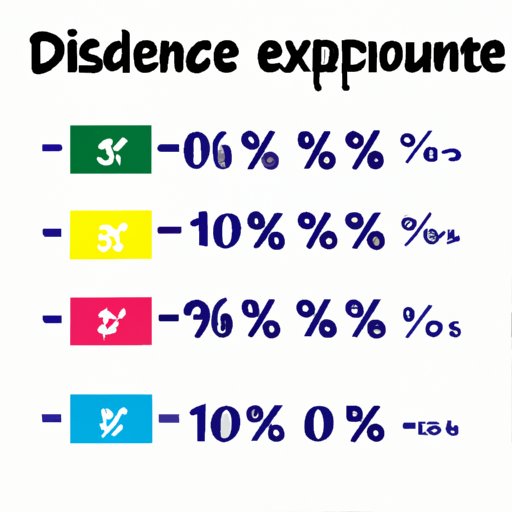
Introduction
Calculating percentage decrease is an important skill in various fields, including finance, business, and economics. It allows individuals to understand changes in values over time or in relative terms. Essentially, percentage decrease measures the amount of decrease in a value over a certain period. For instance, if a stock’s value decreases by 20%, it means that it has decreased by 20% of its original value. In this article, we will provide a step-by-step guide on how to calculate percentage decrease, including practical examples and common mistakes to avoid.
Step-by-Step Guide
To calculate percentage decrease, you need to use the following formula:
((Old value – New value) / Old value) x 100
The old value refers to the original value of the variable, while the new value refers to the current value. Let’s illustrate this using an example:
Suppose Jennifer was earning $10,000 per month, but her salary got reduced to $8,000 per month due to a decrease in work hours. The percentage decrease in her salary can be calculated as follows:
((10,000 – 8,000) / 10,000) x 100 = 20%
Therefore, Jennifer’s salary decreased by 20%.
Visual Aids
Charts, graphs, and images can aid in understanding percentage decrease. For example, a line graph plotting the change in values over time could help visualize the decrease in value. Additionally, step-by-step visuals could be helpful to those who may have difficulty following numerical calculations.
Real-World Example
Suppose you are at the store and see a shirt that’s on sale for 35% off the original price of $50. To calculate the price of the discounted shirt, you need to determine the new price after the discount. The percentage decrease can be calculated using the formula:
((Old value – New value) / Old value) x 100 = % decrease
Therefore, the new price of the shirt can be calculated by:
$50 – ($50 x 35%) = $32.50
The shirt’s discounted price is $32.50.
Comparison
Percentage decrease is just one of several types of percentage calculations. Percentage increase, for instance, calculates the amount of increase in a value over a certain period. Percentage difference, on the other hand, calculates the difference between two values expressed as a percentage of one of the values.
While these calculations may seem similar, they are used in different contexts and can have different implications. Understanding these differences is important for accurate analysis and decision-making.
Practice Exercises
Here are some practice exercises to help improve calculation skills:
1. A company’s revenue decreased from $100,000 to $80,000. What is the percentage decrease?
2. A car that initially cost $25,000 is now worth $17,500. What is the percentage decrease in its value?
3. A bag of apples initially weighed 20 pounds, but it now weighs 16 pounds. What is the percentage decrease in weight?
Worksheets:
1. A company’s revenue decreased from $100,000 to $80,000. What is the percentage decrease?
((100,000 – 80,000) / 100,000) x 100 = 20%
Therefore, the percentage decrease is 20%.
2. A car that initially cost $25,000 is now worth $17,500. What is the percentage decrease in its value?
((25,000 – 17,500) / 25,000) x 100 = 30%
Therefore, the percentage decrease is 30%.
3. A bag of apples initially weighed 20 pounds, but it now weighs 16 pounds. What is the percentage decrease in weight?
((20 – 16) / 20) x 100 = 20%
Therefore, the percentage decrease in weight is 20%.
Common Mistakes
Common mistakes when calculating percentage decrease include:
– Forgetting to subtract the new value from the old value
– Getting the order of old value and new value. Always subtract the new value from the old value
– Using the wrong formula
To avoid these common mistakes, it’s essential to follow the formula carefully, double-check the calculations, and practice regularly.
Conclusion
Calculating percentage decrease is a vital skill that has widespread application in various fields. This guide has provided readers with a step-by-step approach to calculate percentage decrease, including practical examples, visual aids, and practice exercises. Moreover, readers have learned common mistakes to avoid and have compared percentage decrease to other types of percentage calculations, helping them understand the importance of accurate analysis and decision-making. Hopefully, now you feel confident in handling percentage decreases and can apply your skills in real-world scenarios.





